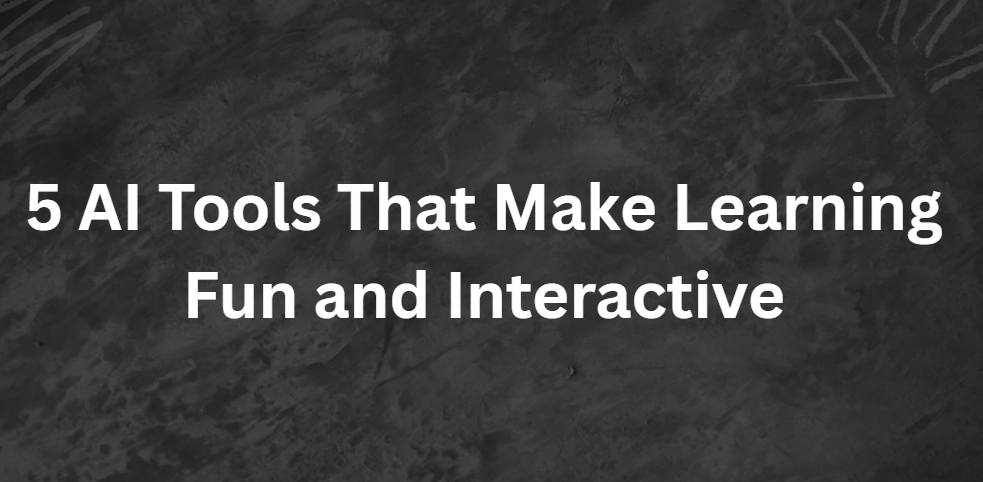Learning doesn’t have to feel boring or difficult anymore. Thanks to artificial intelligence, students and teachers now have access to tools that make lessons more engaging, interactive, and easy to understand. Whether it’s through videos, games, or creative projects, AI can transform traditional education into something exciting. In this article, we’ll look at five AI tools that make learning fun—starting with invideo AI, which is changing the way educational content is created.
1. Invideo AI
Invideo AI has become one of the most popular tools for turning plain text into dynamic and engaging videos. For teachers or trainers, it’s a game-changer because you can take a topic and instantly create an educational video around it. The platform doesn’t just stop at visuals—it can also generate voiceovers, scripts, and even personalized avatars. In fact, its ai talking head video generator makes lessons more relatable by putting a human-like presenter in front of the students, explaining concepts in a simple and clear way. This adds a personal touch that feels much more interactive than just reading from a textbook or slide.
What’s exciting is that invideo has also rolled out an ai video app to make the process even easier. This means educators or students can create videos directly from their mobile devices, without needing expensive software or long editing hours. With its latest update, invideo AI introduced “AI Twins,” which allow teachers to upload a short video or photo and create a realistic digital version of themselves to explain lessons in multiple languages. This makes it incredibly helpful for schools or businesses that want to reach students worldwide. By making video creation fast and interactive, invideo AI ensures that learning feels modern, engaging, and easy to scale.
2. Kahoot!
Kahoot! is already a favorite in classrooms worldwide. It transforms quizzes into interactive games where students can compete in real time using their phones or tablets. Teachers can create custom quizzes on any subject, while students stay motivated through the fun, competitive atmosphere. Its AI features even suggest questions and automatically adjust difficulty levels to keep learners challenged but not overwhelmed. This blend of gaming and learning keeps students active, alert, and excited to participate.
3. Quizlet
Quizlet uses AI to help learners remember information faster through flashcards, practice tests, and games. Its “Learn” mode is powered by machine learning, which adapts to the user’s strengths and weaknesses. For example, if a student struggles with certain terms in biology, Quizlet will automatically repeat those terms until the student masters them. The platform also has an AI-powered “Q-Chat” tutor that works like a study buddy, guiding students through questions and explanations in a conversational way. This makes self-study less stressful and more fun.
4. Duolingo
When it comes to language learning, Duolingo is one of the best-known platforms, and its AI features are a big reason why. The app adjusts lessons based on how quickly a learner picks up new words or grammar. Its gamified system—with points, streaks, and rewards—makes learning a new language feel like playing a game. Recently, Duolingo introduced AI-driven roleplay exercises, where students can practice real-life conversations with an AI chatbot. This helps build confidence and keeps learners engaged without the pressure of making mistakes in front of others.
5. Socratic by Google
Socratic is a smart AI-powered learning assistant that helps students solve problems step by step. Learners can simply take a photo of a question—whether it’s math, science, or literature—and the app explains the answer in an easy-to-understand way. Instead of just giving the solution, it shows the process, which encourages critical thinking. The app also links to videos, articles, and additional resources, making it perfect for students who want to explore a topic deeper. With AI simplifying complex concepts, students feel more confident and motivated to keep learning.
Why AI Makes Learning Better
- Personalized Learning: AI tools adjust content to match each student’s pace, making sure no one feels left behind.
- Engagement Through Interaction: Features like games, quizzes, and avatars make learning feel less like a task and more like an experience.
- Time-Saving for Teachers: Educators can quickly create lessons, quizzes, or explainer videos without spending hours on preparation.
- Accessibility: With AI-powered apps and mobile tools, learning is available anytime, anywhere.
- Confidence Building: Interactive exercises, instant feedback, and supportive AI tutors give students the courage to try, fail, and improve.
Conclusion
AI is changing the face of education by making it more engaging, interactive, and enjoyable. Tools like invideo AI help teachers bring lessons to life with dynamic videos, while platforms like Kahoot!, Quizlet, Duolingo, and Socratic turn studying into an interactive journey. Instead of dreading classes or homework, students now have opportunities to learn through games, personalized guidance, and creative storytelling. By using these AI tools, education can become not just about memorization, but about fun, exploration, and lifelong learning.




